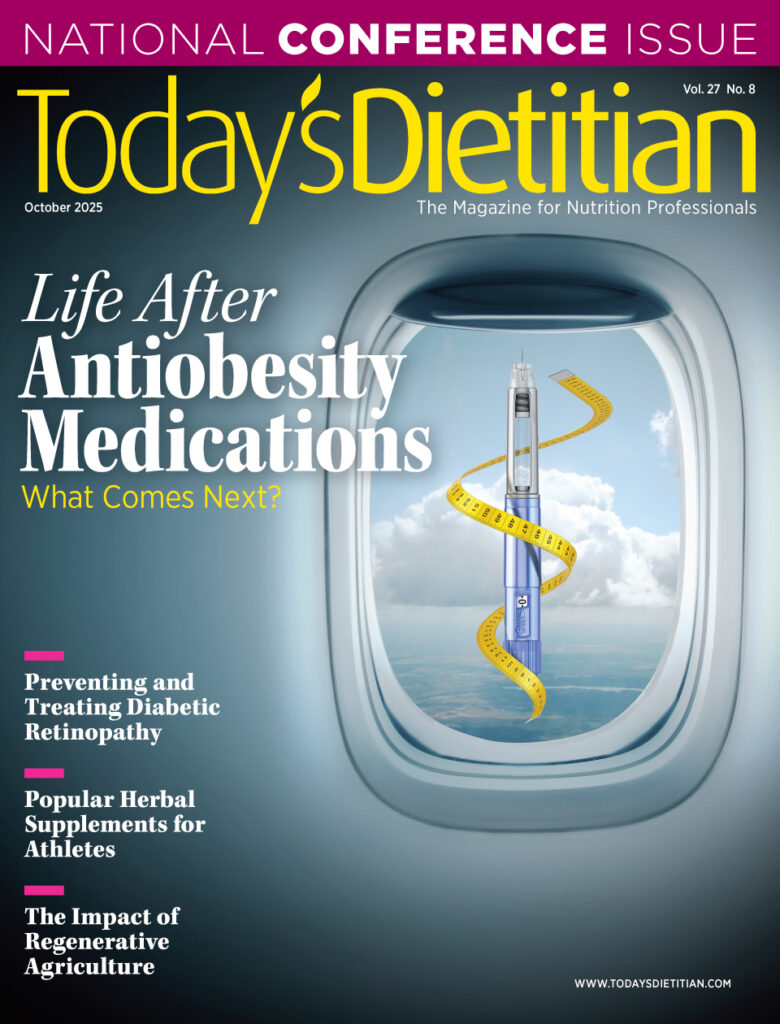By Jenna A. Bell, PhD, RD, CSSD
Today’s Dietitian
Vol. 13 No. 6 P. 8
Despite improved awareness of women’s heart health and scientific contributions influencing the practice of cardiovascular disease (CVD) prevention in women during the past decade, CVD caused one death per minute in women in 2007.1 Contributing to risk factor development, the incidence of type 2 diabetes, and coronary heart disease death rates among women is the epidemic of overweight and obesity.
While recommendations for preventing CVD are similar for men and women, there are certain risk factors unique to women, and they may respond differently to interventions. Gender-specific prevention guidelines are justified considering that more women die from heart disease, stroke, and other CVD diseases than men.1
The American Heart Association (AHA) has updated its guidelines for the prevention of cardiovascular disease in women, first published in 2004, with a transformation from “evidence based” to “effectiveness based” to include preventive therapies that have been shown effective for CVD outcomes not only in randomized control trials but also in physician offices. This is a summary of the update.
Risks Specific to Women
The AHA update recategorizes a woman’s risk of heart disease, lowering the level at which a woman would be considered at high risk. A woman considered at risk must have one or more major risk factors, such as genetic and lifestyle factors, of which dietitians are aware. However, an important addition to this category is risk factors that may be underrecognized in women, including preeclampsia, gestational diabetes, and other pregnancy complications, as well as inflammatory conditions more common in women, such as lupus and rheumatoid arthritis. A meta-analysis found that a history of preeclampsia doubles a woman’s risk of heart disease, stroke, and venous thromboembolic events later in life.2 Considering this, the AHA report states that a history of pregnancy complications may be equivalent to a failed stress test—also an indicator of heart disease risk. Paying special attention to these additional risk factors in women can identify problems early and may prevent CVD from developing.
The AHA recently defined a new concept called “ideal cardiovascular health,” which indicates the absence of CVD; ideal levels of total cholesterol, blood pressure, and fasting blood glucose; a BMI of less than 25; regular physical activity; a Dietary Approaches to Stop Hypertension (DASH)-like eating pattern; and not smoking.
The guidelines also call on healthcare providers to evaluate for possible depression when assessing CVD risk in women because it potentially impacts adherence to therapies.
Heart-Healthy Diet
Class 1 lifestyle recommendations are familiar guidelines emphasized for heart-healthy living and apply to all women:
• Eat a DASH-like diet.
• Engage in recommended levels of physical activity.
• Manage a healthy weight.
• Stop smoking.
The AHA dietary recommendations reflect cardioprotective eating patterns that dietitians typically share with clients and the public—with some updates. The DASH eating plan emphasizes fruits, vegetables, fat-free and low-fat dairy, and whole grains and is shown to reduce CVD risk. It is a positive approach to eating that can help women achieve the recommended daily amount of fiber: 30 g or more per day.
Reflecting a DASH-like diet and the USDA Food Pattern for a 2,000-kcal diet, the updated AHA guidelines also include the following consumption recommendations:
• 4.5 cups of fruits and vegetables per day;
• 3 servings of whole grains per day;
• 2 servings of fish (preferably oily) per week; and
• 4 or more servings of nuts, seeds, and legumes per week in place of other protein sources.
Sodium, Trans Fat, Saturated Fat, and Cholesterol
Echoing the 2010 Dietary Guidelines for Americans, the AHA report includes the less-than-1,500 mg/day-sodium restriction, avoiding trans fat, and limiting saturated fat to less than 7% of total calories to further reduce risk of CVD. To improve LDL cholesterol levels, the AHA guidelines further recommend cholesterol intake stay below 150 mg/day for women, regardless of saturated and trans fat intake. The customary recommendation is less than 300 mg/day.
Sugar and Alcohol
The AHA update provides specific guidance on sugar intake to prevent CVD in women: five or fewer servings per week, with no more than 450 kcal each week coming from sugar-sweetened beverages, the major source of added sugar and excess calories in the American diet.
Alcohol can be beneficial or harmful, depending on the amount consumed. For women who drink, moderate alcohol consumption (one drink per day) is associated with a lower risk of CVD.3
Omega-3s and Fish
Omega-3 fatty acids, either from fatty fish or in supplement form, should be considered for primary or secondary prevention in women with hypercholesterolemia and/or hypertriglyceridemia.
Medications
The guidelines also cover pharmacotherapy and when certain drugs are most effective in women. Some common therapies are recognized for lacking strong clinical evidence in preventing CVD in women, including hormone therapy, antioxidant and folic acid supplementation, and aspirin for lowering myocardial infarction risk in healthy women younger than 65.
More Attention Needed
While the gender-specific prevention guidelines can be applied across all groups, the AHA report mentions health disparities and stresses the need to consider the impact of race and ethnicity on heart disease. For example, the highest coronary heart disease death rates and the highest overall CVD morbidity and mortality occur in black women.3
There is a continual need to publish gender-specific data, including risks and benefits, through every stage of a woman’s life.
— Jenna A. Bell, PhD, RD, CSSD, works in nutrition communications and is a freelance writer living in New York City.
References
1. Roger VL, Go AS, Lloyd-Jones DM, et al. Heart disease and stroke statistics—2011 update: A report from the American Heart Association. Circulation. 2011;123(4):e18–e209.
2. Bellamy L, Casas JP, Hingorani AD, Williams DJ. Pre-eclampsia and risk of cardiovascular disease and cancer in later life: Systematic review and meta-analysis. BMJ. 2007;335(7627):974.
3. Mosca L, Benjamin EJ, Berra K, et al. Effectiveness-based guidelines for the prevention of cardiovascular disease in women—2011 update: A guideline from the American Heart Association. Circulation. 2011;123(11):1243-1262.


